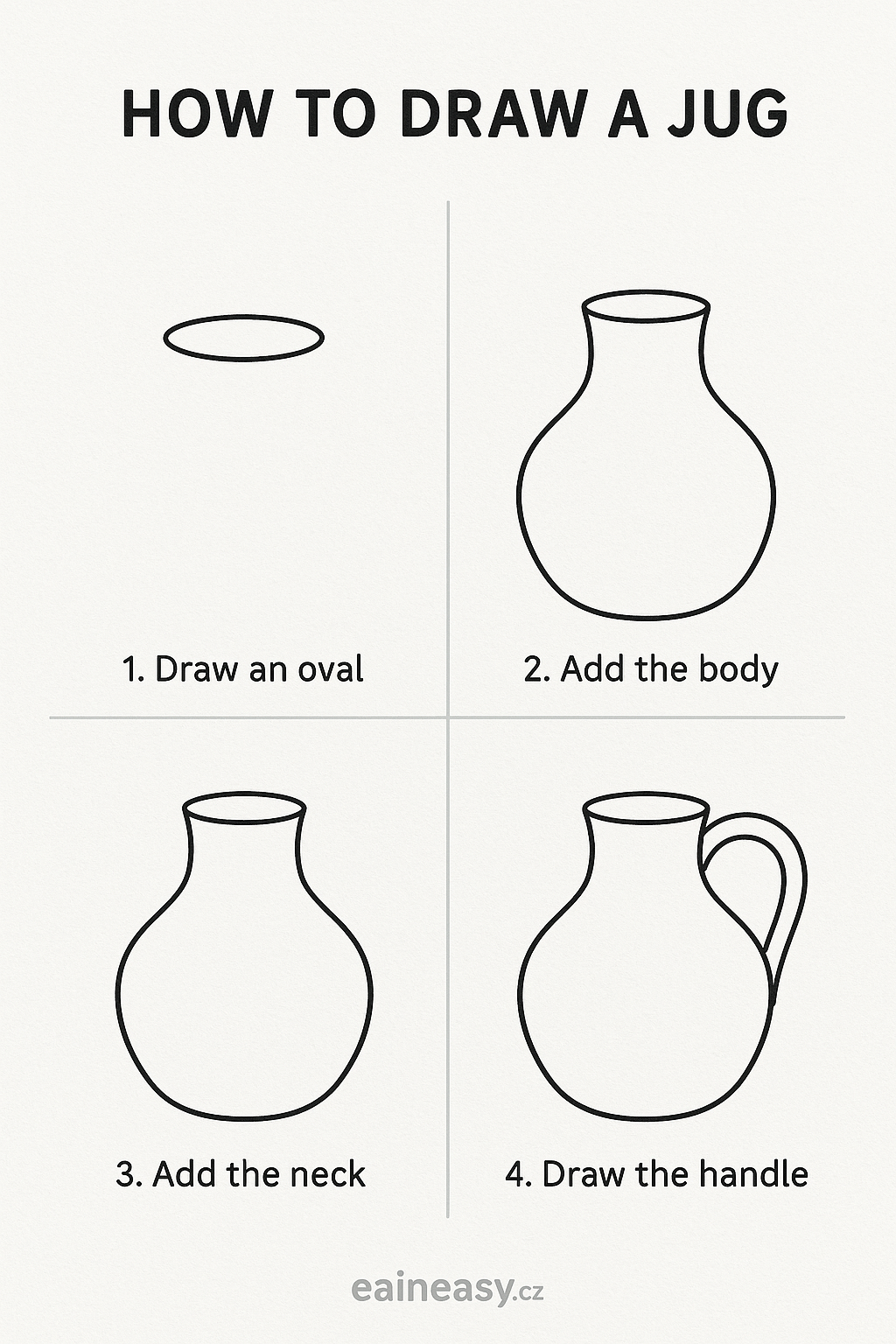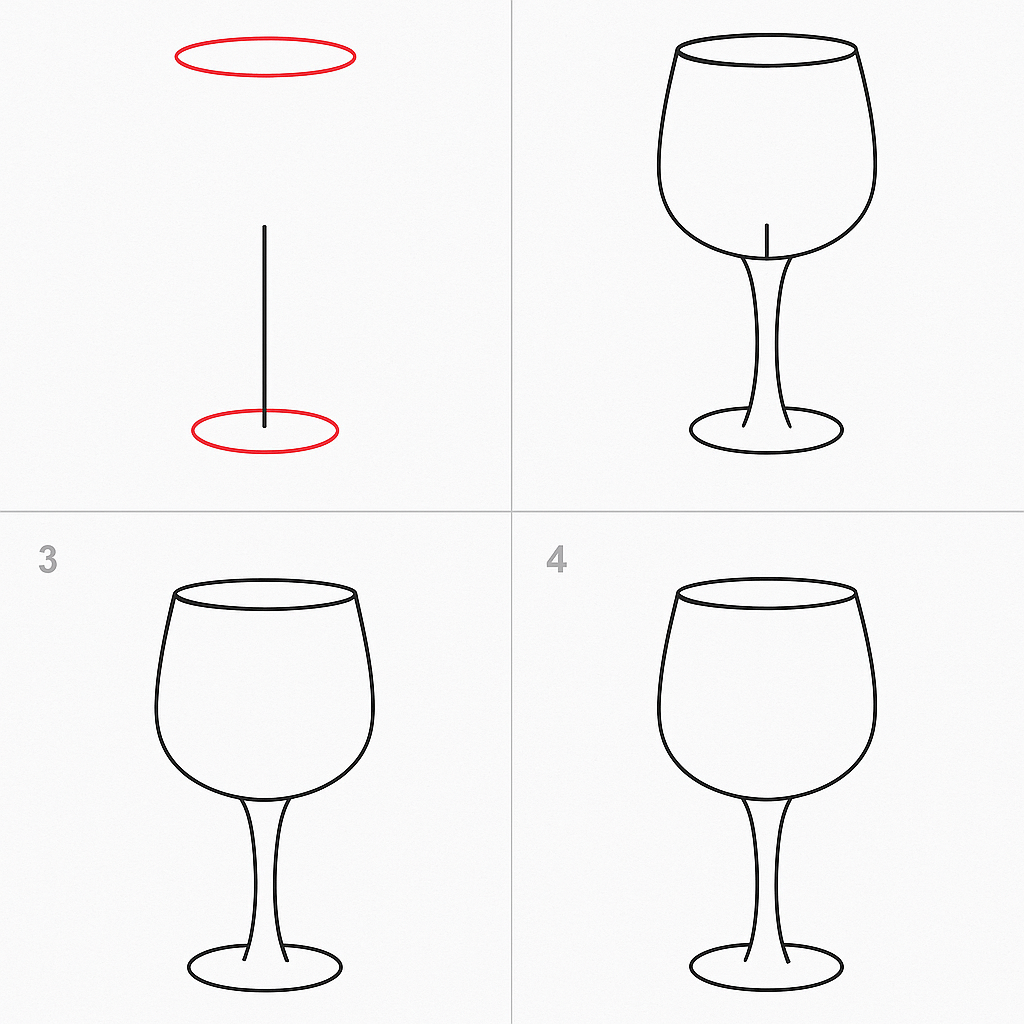Learning to sketch simple objects is one of the most fundamental skills every artist should develop. Two excellent subjects for beginners are the humble jug and the elegant wine glass. These objects offer perfect opportunities to practice essential drawing techniques while building confidence in observational skills.
Understanding Basic Drawing Principles
Before diving into specific objects, it’s crucial to grasp the foundational principles that make any sketch successful. The key to drawing anything lies in breaking down complex forms into simple, manageable shapes. Every object, no matter how intricate, can be reduced to basic geometric forms: circles, rectangles, triangles, and their three-dimensional counterparts.
The Five Essential Questions
When approaching any drawing, ask yourself these fundamental questions:
- What is the biggest shape?
- What is its axis?
- How big does it need to be?
- Where on the page does it need to go?
- What changes can I make?
This systematic approach helps eliminate the overwhelming feeling that often comes with staring at a blank page.
Essential Materials for Sketching
Pencil Selection
For beginners, three pencils provide everything needed for effective sketching 4:
- 2H pencil: Light and sharp, perfect for initial sketches and guidelines
- 2B pencil: Versatile for general sketching and moderate shading
- 6B pencil: Soft and dark, ideal for deep shadows and final details
Paper Choice
Select paper that can handle graphite well. Avoid thin sketch paper that won’t hold enough graphite for proper contrast. Mixed media sketchbooks with 98lb (160g) paper work excellently for dry mediums 6.
Additional Tools
- Kneaded eraser for corrections and highlights
- Blending stump for smooth shading
- Pencil sharpener or sandpaper block
Drawing the Jug: A Step-by-Step Approach

Step-by-step sketching guide for drawing a simple jug
Step 1: Establish Basic Proportions
Begin by observing your jug carefully. Notice that most jugs are taller than they are wide 7. Use the measuring technique: hold your pencil at arm’s length to compare the width to the height. Many jugs have a height approximately twice their width.
Step 2: Sketch the Main Shape
Start with the largest, most obvious shape. For a typical jug, this is usually a rounded rectangle or cylinder 8. Draw this lightly with your 2H pencil, focusing on getting the overall proportions correct rather than perfect lines.
Step 3: Add the Handle and Spout
The handle typically extends from the upper portion of the jug’s body. Sketch it as a simple curved line first, then add thickness. The spout usually emerges from the rim at an angle. Remember to keep these elements in proper proportion to the main body.
Step 4: Refine the Form
Add the jug’s opening at the top – this is typically an ellipse (a flattened circle) due to perspective. The base should be slightly wider than the top for stability. Look for subtle curves in the jug’s profile rather than perfectly straight lines.
Step 5: Add Shading and Details
Using your 2B and 6B pencils, add shading to give the jug three-dimensional form. Identify your light source and shade accordingly. The areas facing away from the light should be darker, while surfaces facing the light remain lighter.
Drawing the Wine Glass: Elegant Simplicity

Step-by-step guide for sketching a wine glass using basic shapes
Understanding Wine Glass Anatomy
A wine glass has three distinct parts:
- Bowl: The rounded container that holds the wine
- Stem: The long, thin connector
- Base/Foot: The flat, stable foundation
Step 1: Establish the Overall Shape
Wine glasses are typically taller than they are wide. Start by sketching a vertical guideline to ensure symmetry. The total height is usually about 6-8 inches, with the bowl taking up roughly half that height.
Step 2: Draw the Bowl
Begin with an oval or ellipse for the top opening of the bowl. From this oval, draw curved lines downward to form the bowl’s shape. Wine glasses typically narrow slightly toward the bottom of the bowl before connecting to the stem.
Step 3: Add the Stem and Base
The stem should be centered under the bowl and drawn as two parallel lines 15. The length varies, but it’s typically about one-third the total height of the glass. The base is usually a flattened oval that’s wider than the stem but narrower than the bowl’s widest point.
Step 4: Refine the Curves
Wine glasses have subtle, elegant curves. The bowl shouldn’t be perfectly round but should have a graceful taper. Pay attention to how the bowl connects to the stem – this transition is usually smooth and flowing.
Step 5: Add Dimension and Shading
Wine glasses present unique challenges because they’re transparent. Instead of focusing on the glass itself, observe the shapes of shadows and reflections. Look for the line where the back edge of the glass shows through the front, creating interesting overlapping shapes.
Common Mistakes to Avoid
Proportional Errors
One of the most frequent mistakes beginners make is getting proportions wrong. Always compare different parts of your subject to each other. Ask yourself: “How does the width of the jug’s body compare to its height?” or “How long is the wine glass stem compared to the bowl?”
Overcomplicating Early Stages
Resist the urge to add details too early. Focus on getting the basic shapes and proportions correct before worrying about surface details, textures, or intricate shading. A well-proportioned simple sketch will always look better than a detailed drawing with poor proportions.
Sketchy, Tentative Lines
Beginners often make timid, scratchy lines 10. Practice making confident strokes. It’s better to draw a slightly imperfect line with confidence than to create a fuzzy, uncertain mark through repeated small strokes.
Ignoring Negative Space
Pay attention to the shapes created around your objects, not just the objects themselves 18. The space between a jug’s handle and body, or the area under a wine glass’s bowl, can help you achieve more accurate proportions.
Developing Observational Skills
The Upside-Down Technique
Try turning your reference image upside down 18. This prevents your brain from inserting what it “knows” about the object and forces you to see actual shapes, lines, and relationships.
Measure and Compare
Use your pencil as a measuring tool. Hold it at arm’s length and use it to compare proportions within your subject. This technique, called “sighting,” helps ensure accuracy in your sketches.
Focus on Shapes, Not Objects
Instead of thinking “I’m drawing a jug,” think “I’m drawing a tall rectangle connected to a curved shape” 18. This mental shift helps you see forms more objectively.
Practice Exercises
Warm-Up Routines
Begin each sketching session with basic shape practice 20. Draw circles, ellipses, straight lines, and curves. This helps develop hand-eye coordination and gets you comfortable with your tools.
Multiple Angle Studies
Draw the same object from different viewpoints. Sketch your jug from the front, side, and three-quarter view. This helps you understand the object’s three-dimensional form better.
Timed Sketches
Set a timer for 5, 10, or 15 minutes and try to capture the essential character of your subject within that timeframe. This prevents overworking and helps you focus on the most important elements.
Building on the Basics
Once you’ve mastered these simple objects, you’ll have developed several crucial skills:
- Breaking complex forms into simple shapes
- Understanding proportion and measurement
- Observing carefully and objectively
- Using basic shading techniques
- Working confidently with your tools
These skills transfer to any subject you might want to draw. Whether you progress to more complex still life arrangements, landscapes, or figures, the principles learned from sketching jugs and wine glasses will serve as your foundation.
Remember, every accomplished artist began with simple objects. Don’t rush the process – enjoy the journey of discovery that comes with careful observation and practice. Each sketch, whether successful or not, teaches you something valuable about seeing and drawing.
The beauty of sketching lies not in creating perfect representations, but in the act of looking closely, understanding form, and translating three-dimensional reality onto a two-dimensional surface. With consistent practice using these simple objects, you’ll develop the confidence and skills needed to tackle any subject that captures your artistic interest.
- https://www.youtube.com/watch?v=SDQEaJY291A
- https://www.youtube.com/watch?v=NsZQ2kYzH8Y
- https://muusart.com/blog/how-to-draw-a-wine-glass/
- https://www.youtube.com/watch?v=-6F5q_5HC3o
- https://www.youtube.com/watch?v=zhfrh3bCgb8
- https://www.youtube.com/watch?v=MYa7_nPmU9M
- https://juliabausenhardt.com/how-to-draw-anything-learn-sketching-for-beginners/
- https://www.youtube.com/watch?v=qxFt1KGN-4E
- https://www.pinterest.com/pin/how-to-draw-wine-glasses-drawing-step-by-step-by-dawn–768145280209123544/
- https://www.youtube.com/watch?v=b5_QJujVkdk
- https://www.youtube.com/watch?v=MlUez7LjG4w
- https://www.pinterest.com/pin/how-to-draw-a-wine-glass-step-by-step-5-easy-phase–838443655622927403/
- https://www.youtube.com/playlist?list=PLDcVY7tIUDzt1iQq-QVIRHB4q1D_-eVeL
- https://www.youtube.com/watch?v=3zVT404zeKs
- https://www.youtube.com/watch?v=hn6oBXX_6YY
- https://www.youtube.com/watch?v=qF9FiWdWEqI
- https://www.youtube.com/watch?v=EF_Opyp7kQM
- https://www.youtube.com/watch?v=A7PKqq7P-gw
- https://www.youtube.com/watch?v=XxnW5h-7W_w
- https://www.youtube.com/shorts/FBmtmY7QN2o
- https://emilysnotebook.co.uk/all-posts/five-basic-drawing-techniques/
- https://luukminkman.com/en/blog/sketching-techniques-for-accurate-proportions/
- https://artbyro.com/drawing-with-shapes/
- https://shop.zenartsupplies.co/blogs/toolkit/sketching-techniques-for-beginners
- https://monikazagrobelna.com/2020/02/10/drawing-101-how-to-draw-proportions/
- https://thevirtualinstructor.com/blog/drawing-basics-construction
- https://www.youtube.com/watch?v=6J4_mBm69Mg
- https://www.youtube.com/watch?v=gMjpAYASbC8
- https://discountartncraftwarehouse.com.au/blog-2138/drawing-techniques-every-artist-should-know
- https://www.douglashydegallery.com/mastering-the-fundamentals-of-drawing-understanding-proportion-perspective-shading-and-composition/
- https://www.youtube.com/watch?v=9vK84953ivs
- https://www.youtube.com/watch?v=OezMavBqWXc
- https://www.youtube.com/watch?v=1J7RQvKnWf4
- https://www.youtube.com/playlist?list=PLDcVY7tIUDzsNR5AjIzqyiN2P85TKAWvb
- https://www.thedrawingsource.com/figure-drawing-proportions.html
- https://www.pinterest.com/a0511390/basic-shapes/
- https://www.youtube.com/watch?v=2szSyXx8cZQ
- https://thevirtualinstructor.com/facialproportions.html
- https://itsybitsy.in/blogs/project-ideas/sketching-and-drawing-for-beginners
- https://www.thinkitchen.in/blogs/latest/wine-glass-vs-champagne-glass
- https://www.bbcmaestro.com/blog/observational-drawing-tips
- https://www.youtube.com/watch?v=n54uJHAVE2g
- https://www.youtube.com/watch?v=cohxaqvJhQc
- https://theartofeducation.edu/2024/09/back-to-basics-spilling-the-tea-on-how-to-teach-observational-drawing-with-confidence/
- https://www.youtube.com/watch?v=p9QcEFQFnVQ
- https://wineware.co.uk/pages/beginners-guide-to-different-types-of-wine-glasses
- https://www.studentartguide.com/articles/realistic-observational-drawings
- https://www.youtube.com/watch?v=Kd-eCn_beF0
- http://advancedmixology.com/blogs/art-of-mixology/wine-glass-dimensions-sizes
- https://www.youtube.com/watch?v=cK0qmT7GzYQ
- https://emilysnotebook.co.uk/all-posts/sketching-materials-for-beginners/
- https://www.dimensions.com/element/iso-wine-tasting-glass
- https://artfulparent.com/observational-drawing-for-kids/
- https://thevirtualinstructor.com/blog/10-essential-drawing-materials-and-tools-for-beginners
- https://www.webstaurantstore.com/guide/580/types-of-wine-glasses.html
- https://www.reddit.com/r/learnart/comments/10eb3yn/how_do_i_improve_my_observational_skills/
- https://www.toadhollowstudio.com/wp_blog/a-beginners-guide-to-drawing-pencils-erasers-and-blenders/
- https://www.marketviewliquor.com/blog/guide-to-different-types-of-wine-glasses/
- https://www.youtube.com/watch?v=GmgDKvLwTaI
- https://www.wineglassesandglassware.co.uk/anatomy-of-a-wine-glass/
- https://www.youtube.com/watch?v=p0dUL7NVMuI
- https://in.pinterest.com/pin/how-to-draw-a-jug-and-glasses-with-basic-shapes-step-by-step–588493876308173014/
- https://www.wienscellars.com/the-science-of-wine-glass-shapes-and-their-effects-on-flavor/
- https://www.haydnsymons.com/blog/beginner-drawing-mistakes/
- https://www.pinterest.com/pin/how-to-draw-a-jug-easy-step-by-step–676314069046392016/
- https://www.winerack.com/tips-and-sips/posts/the-anatomy-of-a-wine-glass–why-it-matters/
- https://urbansketchingworld.com/common-mistakes-beginners-make-learning-to-urban-sketch/
- https://former-students.imperial.edu/025-island/article?dataid=bCg62-0647&title=anatomy-of-wine-glass.pdf
- https://bingedrawing.com/basics/drawing-mistakes/
- https://easydrawings.net/appliance/draw-jug/
- https://ramsgatewinery.com/blogs/rams-gate-winery-blog/explaining-wine-glass-types
- https://thevirtualinstructor.com/blog/the-1-drawing-mistake-made-by-beginners-plus-7-more
- https://chloejadehome.com/blogs/news/types-of-wine-glasses-and-their-uses
- https://www.reddit.com/r/learntodraw/comments/1fhrjqm/what_are_common_mistakes_people_make_when_trying/
- https://wineinsiders.com/blogs/wine-101-serving-wine/wine-glass-guide
